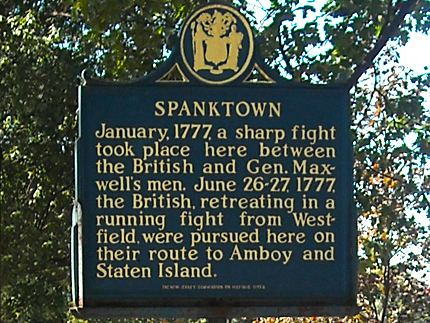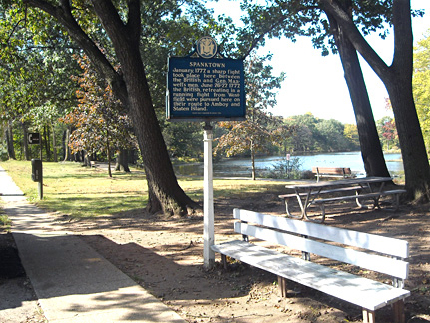


Spanktown
St. Georges Ave.
Outside Rahway River Park
Map / Directions to the Spanktown Marker
Map / Direction to all Rahway Revolutionary War Sites
At the time of the Revolutionary War, Rahway was known as Spanktown and was the site of several military engagements during the war. A historic sign on St. Georges Avenue reads, "January, 1777, a sharp fight took place here between the British and General Maxwell's men. June 26-27, 1777, the British, retreating in a running fight from Westfield, were pursued here on their route to Amboy and Staten Island." [4]
The January 1777 "sharp fight" referred to in the sign occurred on January 5. This was days after the American victory at the Battle of Princeton. The main body of Washington's army was en route to winter quarters in Morristown. During the first three months of 1777, in what became known as the Forage War, American troops skirmished with British troops who were foraging for food throughout New Jersey. The "sharp fight" at Spanktown on January 5, 1777 was part of the Forage War. Several contemporary accounts of the fighting exist:
A letter dated Trenton, January 9, 1777 included the following: [5]
"A regiment of British troops at Spank Town, six miles below Elizabeth Town, was attacked on Sunday by a party of Jersey militia; the encounter continued about two hours. Two regiments marched up from Woodbridge and Amboy to reinforce the enemy, and thus saved them."On January 11, 1777, The Pennsylvania Evening Post reported: [6]
"We are informed that a body of Jersey militia, under Gen. Maxwell, attacked and defeated one regiment of Highlanders and one of Hessian troops at Spank town, on Sunday last. This accounts for a heavy firing heard on that day by different persons towards Princeton." ["Highlanders" referred to the Forty-second Regiment, British Infantry - Highland Watch]Five days later, on January 16, 1777, The Pennsylvania Evening Post followed up with more details: [7]
"By letters from General Washington's army of the eighth, tenth, and eleventh instant, we have the following authentic intelligence, viz. That our army marched from Pluckemin and arrived at Morristown on the sixth; that Gen Maxwell, with a considerable body of Continental troops and militia, having marched towards Elizabeth town, sent back for a reinforcement, which having joined him, he advanced and took possession of the town, and made prisoners fifty Waldeckers [Hessians] and forty Highlanders who were quartered there, and made prize of a schooner with baggage and some blankets on board. About the same time one thousand bushels of salt were secured by our troops at a place called Spank town, about five miles from Woodbridge; when a party of our men attacked the enemy at that place, they sent for a reinforcement to Woodbridge, but the Hessians absolutely refused to march, having heard we were very numerous in that quarter. The English troops at Elizabeth town would not suffer the Waldeckers to stand sentry at the outposts, several of them having deserted, and come over to us.
"The main body of the enemy is at Brunswick; they have also some troops at Amboy, where some men of war and transports are collected, it is supposed to take off the baggage."
New York City was occupied by the British for most of the Revolutionary War, and so when the New York City newspaper, The New York Gazette and Weekly Mercury, reported the January 5 Spanktown fighting, they showed it in a somewhat different light. Their account shifts the emphasis to make the British look better, and the Americans (referred to as "Rebels") look worse. This shows how information could be reported and interpreted differently at the time, depending on which side was reporting - and therefore how difficult it can be to reconstruct the exact events of a battle over two centuries later based on contemporary accounts. The New York Gazette and Weekly Mercury account of the fighting was published on January 13, 1777, as follows: [8]
"On Sunday the 5th Instant, at half an Hour before Sunrise, a party of about 90 Rebels made an Attack upon Lieutenant Cameron of the 46th Regiment, and about 20 of his Men lying at Raway [sic]. They were bravely repulsed with the Loss of one Man killed and three slightly wounded. The Rebels left nine killed behind them. They fled with the more Precipitation upon seeing Lieut. Col. Dongan with about 20 Jersey Volunteers, belonging to Col. Luce's Battalion, coming up to Lieut. Cameron's Assistance."
On February 23, 1777, more fighting involving General Maxwell occurred in Spanktown. (The February 23, 1777 fighting is not mentioned on the sign.) Two different accounts were published the following week in Pennsylvania newspapers. As can be seen, the casualty figures differ in these two accounts, but both accounts list much higher casualties for the British than the Americans, to a degree that seems very unlikely. This most likely can be attributed to the fact that these pro-Independence newspapers were publishing accounts which inflated British casualties and minimized American casualties for the sake of morale.
The following extract of a letter dated February 26, 1777 was printed in The Pennsylvania Packet: [9]
"I was at Gen. Dickenson's last evening when he received the following intelligence, - That on Sunday last about 1000 of our army, under command of General Maxwell, were attacked near Spank Town by near four times their number of the enemy from Perth Amboy, and after an obstinate engagement the enemy were obliged to retreat, with the loss of fifty killed, one hundred wounded, and nine taken prisoners: Our loss is but five killed and nine wounded."The following extract of a letter dated February 26, 1777 was printed in the Pennsylvania Journal and The Weekly Advertiser: [10]
'[British soldiers] were out on Sunday last upon a foraging party with three field pieces, when they were attacked by about 600 of our people at eleven in the morning near Spank-town. The firing continued from that time with some short intermission until night, by the best accounts we can get the enemy's loss amounted to upwards of an hundred men killed and wounded; we took ten prisoners; our loss was eight killed and wounded."
Where the sign states, "June 26-27, 1777, the British, retreating in a running fight from Westfield, were pursued here on their route to Amboy and Staten Island", it is referring to events that took place after the Battle of the Short Hills.
